This year’s IG Nobel Prizes have gone to a study on the effects of wearing cotton, wool or polyester trousers on the sex lives of rats, discovering how to relieve an itch with mirrors, living like a beast, assessing the perceived personalities of rocks, determining why white-haired horses are bitten less by horseflies, being like a goat in the mountains, and why dragonflies are attracted in a fatal way to black tombstones.
The Ig Nobel Prizes honour achievements that make us laugh and then think. According to the prize organisers, they are intended to celebrate the unusual and honour the imaginative, as well as spur our interests in science, technology and medicine.
Every year in September, 1,100 eccentric spectators watch the new winners step forward to accept their IG Nobel Prizes. The prizes are handed out by proper Nobel Prize winners.
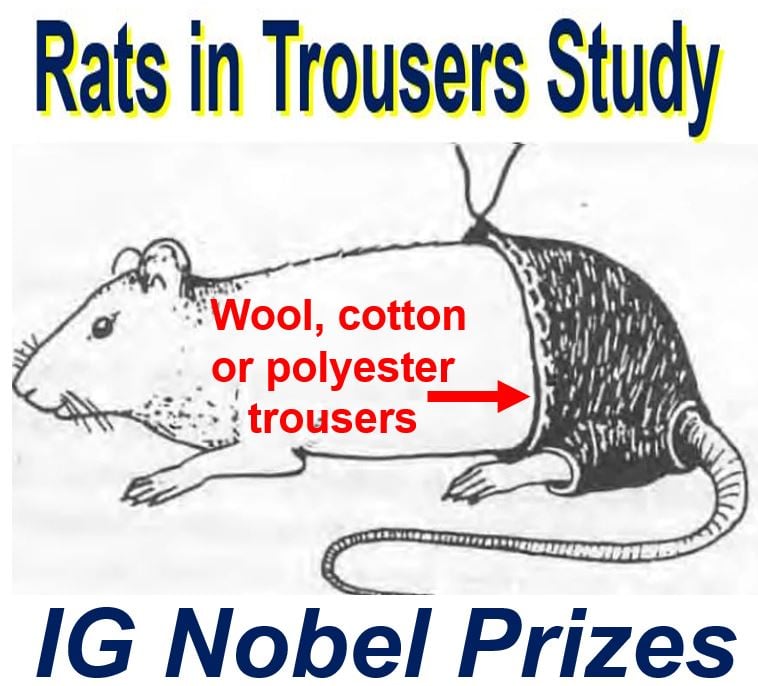 If rats wear wool, polyester or cotton trousers are their sex lives affected in any way? Ahmed Shafik carried out this study more than two decades ago. (Image: scicurious.scientopia.org)
If rats wear wool, polyester or cotton trousers are their sex lives affected in any way? Ahmed Shafik carried out this study more than two decades ago. (Image: scicurious.scientopia.org)
IG Nobel Prizes 2016
This year, on 22nd September, Nobel Laureates handed out the:
– Reproduction Prize: to the late Ahmed Shafik. He studied the effects on the sex lives of rats of wearing wool, cotton or polyester trousers. He then conducted similar tests on human males.
His study on rats – “Effect of Different Types of Textiles on Sexual Activity. Experimental study“ – was published in the journal European Urology in 1993.
His study on human males – “Contraceptive Efficacy of Polyester-Induced Azoospermia in Normal Men“ – appeared in the 1992 edition of Contraception.
Biology Prize: was given jointly to Charles Foster and Thomas Thwaites.
Mr. Foster lived in the wild as a bird, a deer, an otter and a badger at different times.
Mr. Thwaites created prosthetic extensions of his arms and legs that allowed him to move in a goat-like manner and roam the hills in the company of goats.
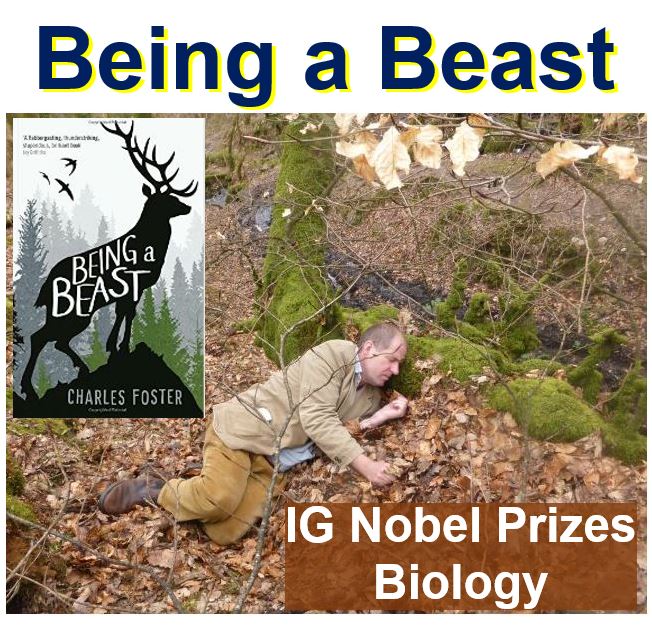 Charles Foster, who teaches medical law and ethics at the University of Oxford, wanted to ‘rewild’ himself. So in his spare time he tried living as an otter, a badger, an urban fox, a red deer and a swift. (Image: oxfordtoday.ox.ac.uk)
Charles Foster, who teaches medical law and ethics at the University of Oxford, wanted to ‘rewild’ himself. So in his spare time he tried living as an otter, a badger, an urban fox, a red deer and a swift. (Image: oxfordtoday.ox.ac.uk)
Mr. Foster’s experience – “Being a Beast” – was published by Profile Books in 2016.
Mr Thwaites’ paper – “GoatMan – How I Took a Holiday from Being Human” – appears in a 2016 issue of the journal Princeton Architectural Press.
Economics Prize: to Shelagh Ferguson, Sarah Forbes and Mark Avis for assessing the perceived personalities of rocks, but from the perspective of sales and marketing personnel.
Their study – “The Brand Personality of Rocks: A Critical Evaluation of a Brand Personality Scale“ – was published in the journal Marketing Theory in 2014.
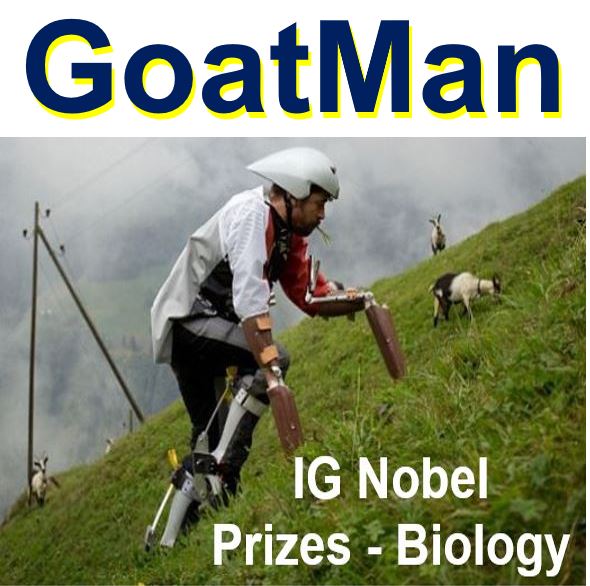 Thomas Thwaites said he tried to become a goat to get away from the angst inherent in being human. The project became an exploration of how close technology today can take us to fulfilling an ancient human dream – to take on the features and characteristics of other animals. He made the prosthetic limb extensions himself so that he could walk around just like a goat. (Image: twitter.com/Thomas_Thwaites)
Thomas Thwaites said he tried to become a goat to get away from the angst inherent in being human. The project became an exploration of how close technology today can take us to fulfilling an ancient human dream – to take on the features and characteristics of other animals. He made the prosthetic limb extensions himself so that he could walk around just like a goat. (Image: twitter.com/Thomas_Thwaites)
Chemistry Prize: went to the German automobile maker Volkswagen, for solving the problem of excessive car pollution emissions by automatically, electromechanically producing lower emissions every time its cars were being tested.
Details on how the company managed to trick the authorities – “EPA, California Notify Volkswagen of Clean Air Act Violations” – were published by the US Environmental Protection Agency in 2015.
Physics Prize: went to Susanne Åkesson, Péter Malik, Hansruedi Wildermuth, Gábor Horváth, Miklós Blahó, György Kriska, Ramón Hegedüs, Balázs Gerics and Róbert Farkas for finding out why white-haired horses are more horsefly-proof than darker horses.
The team also discovered why dragonflies are fatally attracted to black tombstones.
The white-haired horses study – “An Unexpected Advantage of Whiteness in Horses: The Most Horsefly-Proof Horse Has a Depolarizing White Coat“ – appeared in a 2010 edition of Proceedings of the Royal Society B.
The study on dragonfly and black tombstones – “Ecological Traps for Dragonflies in a Cemetery: The Attraction of Sympetrum species (Odonata: Libellulidae) by Horizontally Polarizing Black Grave-Stones” – was published in the journal Freshwater Biology in 2007.
THURSDAY: The 26th First Annual Ig Nobel Prize ceremony (and webcast) – https://t.co/31g1ot0d0C pic.twitter.com/I132jyLA4u
— Improbable Research (@improbresearch) September 21, 2016
Medicine Prize: went to Andreas Sprenger, Thomas Münte, Silke Anders, Christoph Helmchen and Carina Palzer for discovering that if a person has an itch on the left side of the body, it is possible to relieve it by looking into a mirror and scratching the other side – the right side – of the body.
The same effect can be achieved by scratching the left side of your body when you look into a mirror and the itch is on your right side.
Their study – “Itch Relief by Mirror Scratching. A Psychophysical Study“ – appeared in a 2013 issue of the journal PLoS One.
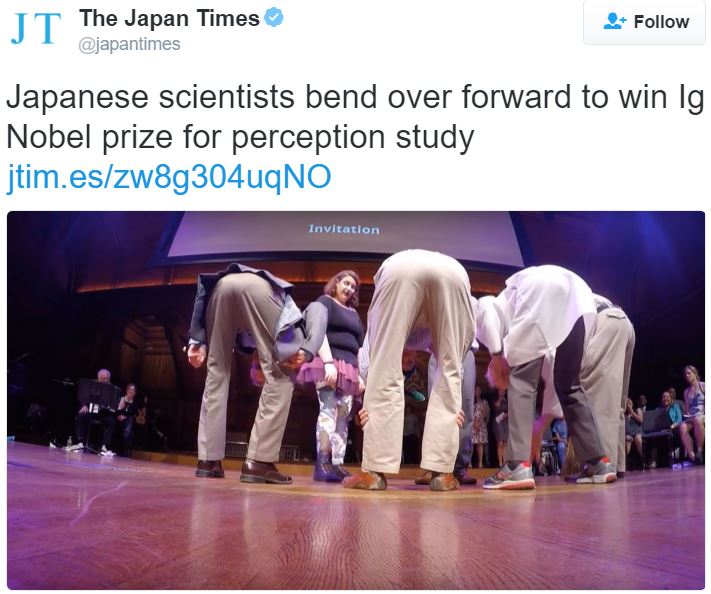 Japanese scientists demonstrate a different perspective by peering between their legs. Professors Atsuki Higashiyama and Kohei Adachi won the Perception Prize for their research. (Image: twitter.com/japantimes)
Japanese scientists demonstrate a different perspective by peering between their legs. Professors Atsuki Higashiyama and Kohei Adachi won the Perception Prize for their research. (Image: twitter.com/japantimes)
Psychology Prize: went to Bruno Verschuere, Kristina Suchotzki, Evelyne Debey, Gordon Logan and Maarten De Schryver for asking one thousand liars how often they tell lies, and then determining whether to believe their answers.
Their study – “From Junior to Senior Pinocchio: A Cross-Sectional Lifespan Investigation of Deception” – appeared in a 2015 issue of the journal Psychologica.
Peace Prize: went to Jonathan Fugelsang, Derek Koehler, James Allan Cheyne, Gordon Pennycook and Nathaniel Barr for their academic study on the detection and reception of pseudo-profound bullshit.
Their scholarly paper – “On the Reception and Detection of Pseudo-Profound Bullshit“ – was published in the journal Judgment and Decision Making in 2015.
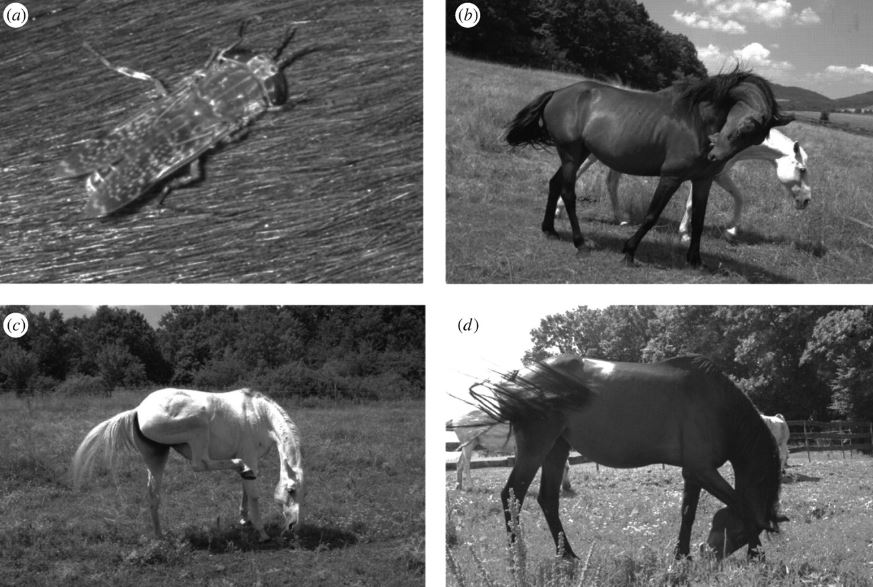 Scientists discovered that white horses get significantly fewer horsefly bites compared to their darker cousins. Their coats depolarise light which insects use for nagigation. (Image: rspb.royalsocietypublishing.org)
Scientists discovered that white horses get significantly fewer horsefly bites compared to their darker cousins. Their coats depolarise light which insects use for nagigation. (Image: rspb.royalsocietypublishing.org)
Literary Prize: went to Fredrik Sjöberg who wrote three volumes – an autobiographical work – about the pleasures of gathering flies that are dead, and also flies that are not dead yet.
A paper on his work – “The Fly Trap“ (the first volume of his trilogy) and “En Flugsamlares Vag” (“The Path of a Fly Collector”) – were published by Pantheon Books in 2015.
Perception Prize: went to Kohei Adachi and Atsuki Higashiyama for carrying out an investigation on how things look depending on our positions.
Specifically, they investigated whether things look the same or different when we bend over and view them between our legs.
Their study – “Perceived size and Perceived Distance of Targets Viewed From Between the Legs: Evidence for Proprioceptive Theory” – was published in a 2006 issue of Vision Research.
IG Nobel Prizes 2016
The twenty-sixth Fist Annual IG Nobel Prize Ceremony, introduced by 10 new Nobel laureates.

